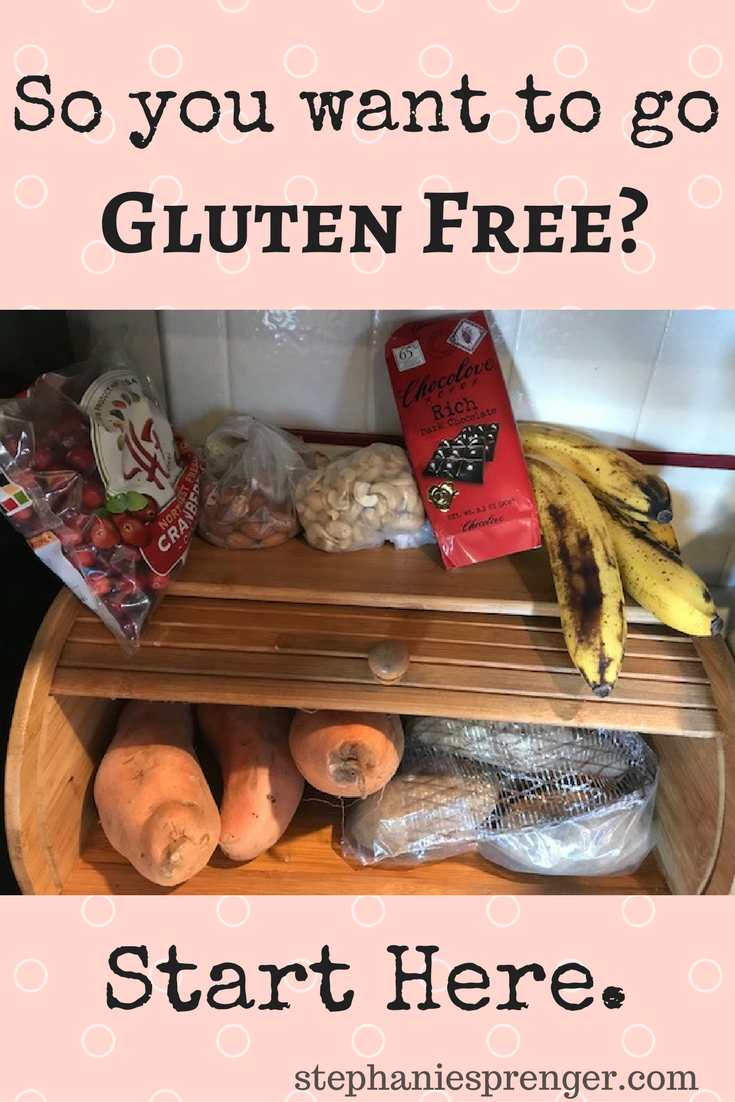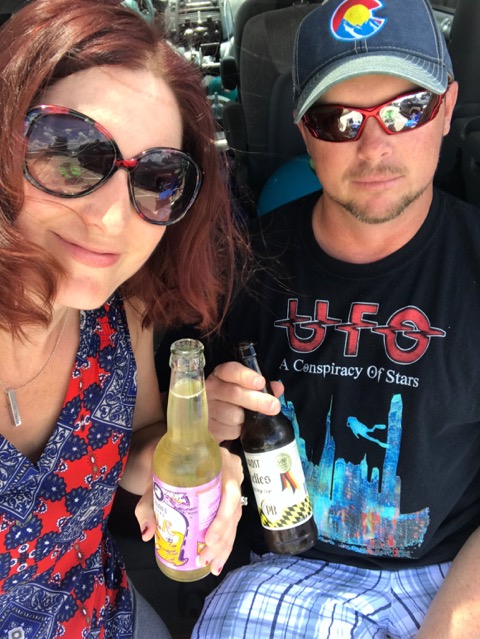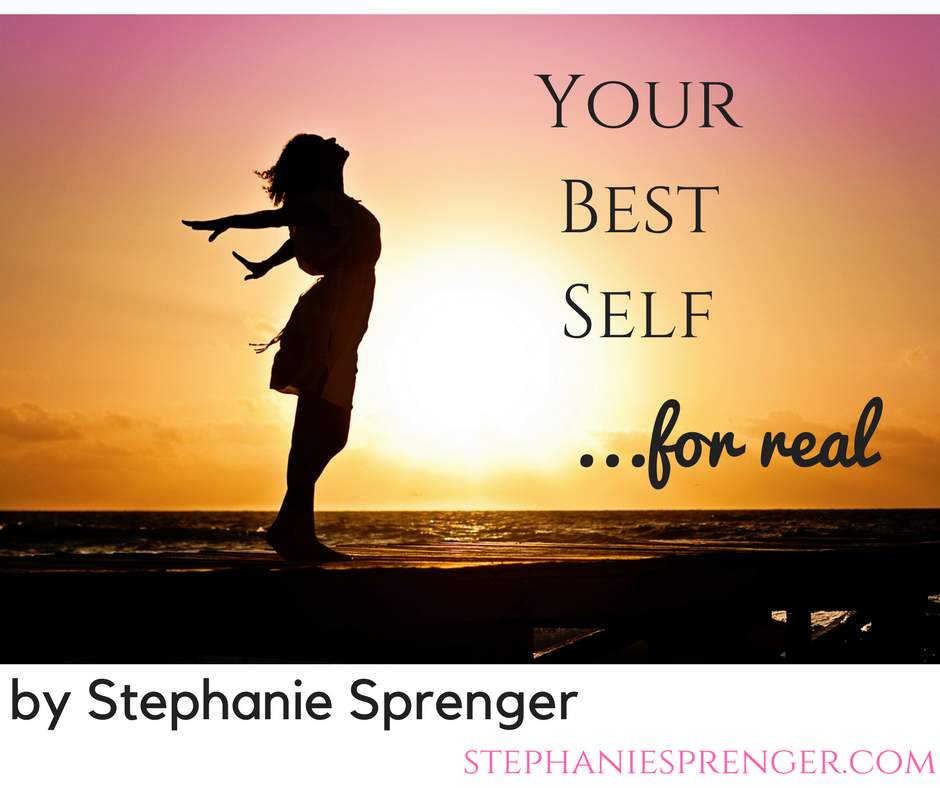It has been nearly four months since I went gluten free, and aside from a few “accidental glutenings” (glutened is totally a verb now), I have stuck with it completely. And at the risk of sounding dramatic, it has completely changed my life.
If you haven’t read my blog post “What Happened When I Went Gluten Free,” let me fill you in quickly. My husband suggested we try going gluten free, just for a couple weeks, to see what happened. We wanted to know if it would make a difference in our joint pain and stiffness.
After doing a tiny bit of research, I realized that 30 days was really the minimum to see a significant change and to give the gluten a chance to get out of your system a little bit more. So we put in our 30 days.
I didn’t notice much in the way of joint pain (note: this can actually take quite a while to happen) but after a week or two, I noticed I hadn’t had heartburn at all since giving up gluten. I have struggled with acid reflux ever since I was diagnosed with achalasia, an autoimmune swallowing disorder, when I was pregnant with my second daughter. Since then, I have had six plus years of twice daily Prevacid, Pepcid and Alka Seltzer as needed, and plenty of nights sleeping upright. Even when I didn’t have a major episode, I had mild heartburn at least once or twice a week.
By the thirty-day mark, I was still free from reflux. The day after our gluten free month ended, I tried a few bites of my daughter’s bagel. Things seemed to be fine. Until the next day, when my stomach swelled to resemble about 20 weeks of pregnancy, and I was up all night with heartburn.
I immediately went back to my gluten free diet, and have only had heartburn episodes twice since then, both from accidental “glutening.” (Pro tip: Campbell’s tomato soup has flour in it, and many chewable Vitamin C vitamins also contain gluten. Consider yourself warned.)
So it’s pretty clear that I actually have a serious intolerance to gluten. I had some blood work done recently to see if it’s possible I have undiagnosed Celiac (no results yet), but either way, I’m afraid gluten is out of my life for good.
Even though I seem to have a pretty extreme reaction to gluten, I would still encourage people without clear medical needs to try going gluten free. Because here’s the thing: I honestly had no idea I had a problem with gluten. At all. The fact that it eliminated my acid reflux was one of the biggest surprises of my life. (Losing 23 pounds after trying unsuccessfully for over 5 years was also pretty freaking surprising.)
I should also add that, a few months after going gluten free I reduced my Prevacid dose from twice a day to once, and effective two weeks ago, I have completely discontinued my acid reflux medication. Kind of crazy, right? (Also worth noting that it’s kind of crazy that no doctor ever suggested I try going gluten free, but I digress.)
So you may not actually know the scope of your body’s response to gluten until you’ve tried giving it up. Whether it’s weight gain, blood sugar, autoimmune issues, joint pain, or digestive problems, gluten is frequently the culprit or at the very least, a complicating trigger, and the only way to find out is to try giving it up.
But it’s overwhelming, right? You don’t know where to start and you’re worried about the deprivation issue. I completely get it. So I’m going to give you my best tips for trying a gluten free diet. Are you ready?
1. Make a plan
If you go into this thing without a clear plan, you are way more likely to fail. The first thing I did after we decided to go gluten free was to make a list of foods I was planning to eat during the first week and I wrote a grocery list. I stuck my “breakfast, snack, and lunch ideas” list to my fridge where I could always see it. I included things like: oatmeal, eggs, fruit, carrot sticks, cucumber slices, hummus, almonds and cashews, sliced cheese, salami or ham roll-ups, salads, soups, and yogurt. It helps to pick foods that a) you already like and b) are reasonably healthy choices.
Then make a weekly meal plan. Every weekend, I write out my meal plan for the whole week and then I go grocery shopping. The first “gluten free” trip was a big one, but I had included all of our dinner choices, breakfast and lunch options, and snacks I could easily take with me to work and appointments if I felt hungry. I was actually excited about my new meal plan and the food options that fell within it. Set yourself up for success by fully stocking your kitchen (and purse, and car) with GF foods so you don’t get sidetracked.
2. Make a Commitment
Give yourself 30 days. That’s all. Honestly, if I had known once we went off gluten that I was going to be gluten free for, likely the rest of my life, I would have been very sad and overwhelmed. Now that I am on the other side of it, I can clearly see that the health trade off and weight loss is well worth the sacrifice of giving up gluten. But on Day One if I was like, this is it forever, wheat, I may have been too overwhelmed to start. So tell yourself it doesn’t have to be forever: you’re just trying it.
But don’t cheat. Any amount of gluten in your body is going to discount the elimination effort. If you are having an inflammation response to gluten and you are gluten free six days a week but eat bread on the seventh, it just doesn’t count. I know; it pissed me off when I discovered this as well. I really thought I could just reduce the gluten and it would make enough of a difference in my life, but I’m afraid that, at least during your 30-day trial, you really need to go all in. But guess what? You totally CAN do this.
(I know some people really love doing “The Whole 30” thing, but honestly I think it’s less overwhelming to start with just one big diet change. Plus, it’s easier to attribute any changes when you’re not wondering whether your weight loss/progress/energy changes are from cutting out the dairy, gluten, grains in general, etc. But that’s just my perspective!)
And at the end of 30 days, try some gluten and see how you feel. Which brings me to:
3. Write it All Down
Keep a food journal. It’s fun, I promise! Write down every meal and snack you eat, whether you exercise, and also keep track of your energy, mood, and digestion. Make sure to jot down digestive changes, how your body feels, and how tired you are. That way you can easily look back and see the bigger picture; it’s hard to remember everything as you go. And if you start experiencing relief from pain, digestive discomfort, or any other unexpected issue, you want to clearly document it!
4. Remember That It’s Easier Than You Think!
My husband and I were pretty surprised at how easy it was for us to remove gluten from our diets. Grocery stores make it super easy to shop: ours labels all gluten free items with GF on the tag on the shelf, and many have entire GF sections. Many restaurants also have gluten free menus, or at least GF options like pizza crust and hamburger buns (thank you, Udi’s!) There is even gluten free beer, which, according to my husband, is not gross at all. (Locals, Golden even has an entire GF brewery! For real.) Wine, cider, and many liquors are GF.
There are so many GF alternatives to the foods you love to eat. Some of them are straight up alternatives, and other are close substitutes. And this is a super important point:
5. Find a Healthy Balance of “Gluten Free” Products and Just Plain Different Foods
Does this make sense? Here’s what I mean. If all of a sudden on your new GF diet you are eating GF pizza, GF pasta, GF bread, GF buns, GF pancakes, GF tacos, and GF pastries, you aren’t really getting the maximum benefit. If you have a true gluten sensitivity, then sure, eliminating gluten alone is going to make a positive impact on your health. But if weight loss, blood sugar, your immune system, and even just your overall health is part of this plan, filling your diet with replacement starches like corn starch, potato starch, and rice products isn’t the way to go.
So, again, balance is the key word. We have Friday night pizza nights at my house, and we have pancakes once per weekend. I have kept this up on my GF diet and have still reaped health benefits. I have mostly limited bread to special occasions, rare indulgences, and eating burgers at restaurants (which we don’t do a ton of). But if bread is the biggest issue for you, then for God’s sake, find some good gluten free bread and eat it!
Go ahead and have corn tortillas, GF burger buns, GF pizzas, etc. But don’t make it a straight substitution most days of the week: branch out. Maybe try almond or coconut flour for baking instead of a GF blend containing rice or potato. Just skip the carb side at dinner sometimes and try two vegetables. Eat your protein at lunch without bread or wraps. Try lettuce wraps. Focus on protein, vegetables, and fruits more often. (Yeah, I’m pretty much talking about paleo. Sorry.)
If you can have more of a plant-based diet, you are going to be bringing so much more health and energy to your life, I promise. But deprivation is not a solid place to begin a GF lifestyle, so please do yourself a favor and indulge in some GF pizza or bread from time to time. Just use moderation.
We had some crazy good dinners at my house this week: grilled salmon with carrot “fries” (like sweet potato fries! Super good.), and sauteed ginger-lime kale; baked sweet potatoes with sauteed spinach and bacon crumbles on top, chicken soup with veggies, curried cauliflower bites with chicken skewers, turkey meatball lettuce wraps . . . I mean, it’s like I don’t even know who I am anymore. Oh! You guys should follow my “Gluten Free Cooking” board on Pinterest.
Do you see this breadbox? Ours used to be jammed with several different breads, bagels, and English muffins, and the countertop surrounding it had overflowing bags of chips and crackers, pretzels, and Goldfish crackers. Now? Sweet potatoes, regular potatoes, fruit, raw nuts, and yes, dark chocolate.
6. Find the Best Gluten Free Food Out There
So I just mentioned that more veggies and fruits are better, of course. But when you want some solid GF options, here are a few of my favorites.
Flour for baking and pancakes: Pamela’s Baking and Pancake Mix
(It’s great, and has some brown rice flour and almond flour, so definitely not the least healthy. I’ve had great success with it!) People love Cup4Cup, but it was too gluey and gummy for me. My kids loved the muffins I made from it . . . the first ingredient is cornstarch, so that kind of explains that.
Bread: Udi’s is OK, but their restaurant buns and bread are WAY better than the stuff you can get at the store. Out of the Breadbox is the best one we have tried. Our grocery store has like a billion different GF bread brands, for real: try a bunch and take notes on your favorites!
Pasta: We like Tinkyada, which is brown rice pasta. One of my doctors, who has 3 daughters with Celiac, says that kind is gross and prefers Ronzoni. Which is technically less healthy, because corn is the primary ingredient, but if you really want great tasting pasta you might want to go that route. Even Barilla makes GF pasta, and I’ve heard their GF lasagna noodles are amazing!
Pizza: We have tried Papa Murphy’s, Dominos, Papa John’s, and some fancy local pizzas that seriously have the best GF pizza crust ever. Of those chain ones, all are perfectly fine but not awesome. Our favorite? A frozen cheese pizza from Costco: Sabatassos. We put our own ingredients on top, and the crust almost made me cry it was so good.
Restaurants: We live in Colorado, and many restaurants here have amazing GF options. Abrusci’s Fire and Wine is far and away the best, Carrabba’s has great GF choices, Teller’s has that amazing GF Udi’s bread, and most of our favorite Mexican places have solid GF choices, because, corn tortillas. Use the “Find Me Gluten Free” app to find GF restaurant options where you live: it has been amazing when traveling, too.
Costco has been our best friend for GF products, whether chips and crackers, cooking supplies, even frozen foods. Trader Joe’s GF products are also pretty legendary. Go to either place on a mission and stock up, but only after you made your meal and snack grocery list!
7. Beware of Hidden Gluten!
Read labels, read labels, read labels. It’s annoying for sure, but besides my aforementioned tomato soup and chewable Vitamin C, gluten hides everywhere. Sauces for sure, especially BBQ and marinades. Soy sauce almost always contains wheat. Processed meats and brats can contain gluten unless otherwise labelled. Soups are tricky. The ingredient “maltodextrin” can indicate gluten unless the product specifically says “gluten free.” Medications, vitamins, and supplements sometimes contain gluten, but most labels will clearly state “gluten free” if it’s safe.
Just get into the habit of checking for GF written on labels, and if it isn’t, search for wheat, barley, and rye. Many labels indicate that a food is not GF simply because it was processed in a facility that also processes wheat: if you don’t have Celiac or a true intolerance, this may not be a problem for you.
8. Find a Gluten Free Community
Reach out and talk about this stuff! Honestly, given that I was such a judgey A-hole about gluten-free everything and nutrition changes in general, it’s shocking to me how many people have contacted me to connect about going GF. And also shocking is how much I love talking about it. I really do. So be brave and speak up! Share your story, find a friend or loved one to do it with you, and at the very least, connect with me here and on Facebook. I am happy to answer any questions you have about going GF.
9. Feel Your Hard Feelings
I have cried about giving up gluten, many times. Once, someone brought my favorite cookie dough over to my house. I had to leave the room to weep. I got choked up watching family members eat fried pickles at a restaurant. Birthdays and other parties and favorite restaurants are the hardest. So maybe you start by sticking close to home, where you have full control and can feel empowered and inspired in your own kitchen.
Bring alternative snacks to gatherings and plan ahead by researching restaurant menus (and checking the “Find Me Gluten Free” app) ahead of time to prevent epic food disappointment.
And when that epic food disappointment happens? Just be sad. And pissed. And maybe you will be eating those foods again in a matter of days or weeks. But maybe you will realize that GF is a change you need to stick with, and if that’s the case, let yourself feel the legitimate food grief about what you are giving up. Even if it’s ultimately worth it, it’s still freaking hard.
10. Be Prepared: Going Gluten Free May Only Be the Beginning
I have so much to share with you guys! Giving up gluten was just the start for me. But I don’t want to overwhelm you, so it can wait. Don’t worry: you don’t have to give up everything you love just because you went gluten free. I promise. But you may be shocked at how much better you feel, how much energy you have now, and how symptoms and pounds may drop away. And sometimes that feeling may cause you to dig deeper into your own health, motivate you to eat cleaner in general, and inspire you to read and learn more about nutrition, health, and your body. If that happens? Go there! It is truly amazing to reclaim your own health, especially if you have paved your own way and done so not at the urging of a doctor.
This post is the beginning of a new series I have started: Your Best Self, For Real. I am going to keep sharing my own experiences with health, nutrition, stress management, and yes, even a little fashion, dammit, because I am finally feeling vibrant again and wearing clothes I love makes me happy! So stay tuned, and please let me know: What are you interested in learning about? Are there books you want me to read and try, products to test? Do you have questions about going gluten free or anything else at all? Leave me a comment or contact me above. I’m looking forward to this, and also? Congratulations for even thinking about it!
—xoxo, Stephanie
Mommy, for Real on Facebook
Don’t miss a post! Sign up below:
[jetpack_subscription_form]














Great post Stephanie! I’ll be following along because I’m thinking about trying a gluten-free diet…For me, the one thing holding me back is that I hate to cook, not just a little, but a lot. However, being the mom to 3 boys, I of course do prepare dinners, but they are usually meals suited to hungry boy appetites. 2 of my boys are now away at school and not living here full-time, so with just 3 of us at home most of the time, I might be persuaded to give this a shot. Still, if you can offer any tips for going gluten-free and not spending so much time in the kitchen, I’m all ears. 🙂
Great article- I’ve been GF for over 16 yrs, the bread was REALLY NASTY back in 2000. I have Celiac Disease and was diagnosed after Celia was 4 yrs old. It’s quite familial- we’ve been tested and my two daughters are positive, 3 sisters and my father.
I’m so glad that your reflux is better-
My father is 92 and lives in Assisted Living. The dietary mistakes they make with his GF diet is endless- soups, pasta, a dinner roll on his plate, breaded chicken. It is so frustrating! He can’t do the shopping and cooking like we can- this is an important area that needs attention. The elderly are so vulnerable.
Janie
I thought you were looking slimmer and happier last time I saw you!
Thanks Teal!